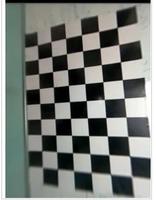使用Python进行相机校准 – OpenCV
先决条件: OpenCV
相机是机器人、太空探索等多个领域不可或缺的一部分,相机发挥着重要作用。它有助于捕捉每一刻,并有助于许多分析。为了将相机用作视觉传感器,我们应该知道相机的参数。相机校准只不过是估计相机的参数,需要有关相机的参数来确定现实世界中的 3D 点与其在该校准相机捕获的图像中对应的 2D 投影(像素)之间的准确关系。
我们需要考虑镜头的焦距、光学中心和径向畸变系数等内部参数,以及相机相对于某些现实世界坐标系的旋转和平移等外部参数。
需要的库:
- OpenCV Python中的库是一个计算机视觉库,主要用于图像处理、视频处理和分析、人脸识别和检测等。
- 麻木 是一个通用的数组处理包。它提供了一个高性能的多维数组对象和用于处理这些数组的工具。
相机校准可以分步完成:
- 步骤 1:首先使用已知大小的棋盘图案定义 3D 点的真实世界坐标。
- 步骤2:捕获棋盘图像的不同视点。
- 第3步: findChessboardCorners()是OpenCV中的一个方法,用于寻找不同图像中每个3D点的像素坐标(u,v)
- 步骤 4:然后使用calibrateCamera()方法查找相机参数。
它将以我们计算的(threedpoints、twodpoints、grayColor.shape[::-1]、None、None)作为参数,并返回包含相机矩阵、失真系数、旋转向量和平移向量等元素的列表。
相机矩阵有助于将 3D 对象点转换为 2D 图像点,并且失真系数返回相机在世界中的位置,以及旋转和平移向量的值
以下是上述方法的完整程序:
Python3
# Import required modules
import cv2
import numpy as np
import os
import glob
# Define the dimensions of checkerboard
CHECKERBOARD = (6, 9)
# stop the iteration when specified
# accuracy, epsilon, is reached or
# specified number of iterations are completed.
criteria = (cv2.TERM_CRITERIA_EPS +
cv2.TERM_CRITERIA_MAX_ITER, 30, 0.001)
# Vector for 3D points
threedpoints = []
# Vector for 2D points
twodpoints = []
# 3D points real world coordinates
objectp3d = np.zeros((1, CHECKERBOARD[0]
* CHECKERBOARD[1],
3), np.float32)
objectp3d[0, :, :2] = np.mgrid[0:CHECKERBOARD[0],
0:CHECKERBOARD[1]].T.reshape(-1, 2)
prev_img_shape = None
# Extracting path of individual image stored
# in a given directory. Since no path is
# specified, it will take current directory
# jpg files alone
images = glob.glob('*.jpg')
for filename in images:
image = cv2.imread(filename)
grayColor = cv2.cvtColor(image, cv2.COLOR_BGR2GRAY)
# Find the chess board corners
# If desired number of corners are
# found in the image then ret = true
ret, corners = cv2.findChessboardCorners(
grayColor, CHECKERBOARD,
cv2.CALIB_CB_ADAPTIVE_THRESH
+ cv2.CALIB_CB_FAST_CHECK +
cv2.CALIB_CB_NORMALIZE_IMAGE)
# If desired number of corners can be detected then,
# refine the pixel coordinates and display
# them on the images of checker board
if ret == True:
threedpoints.append(objectp3d)
# Refining pixel coordinates
# for given 2d points.
corners2 = cv2.cornerSubPix(
grayColor, corners, (11, 11), (-1, -1), criteria)
twodpoints.append(corners2)
# Draw and display the corners
image = cv2.drawChessboardCorners(image,
CHECKERBOARD,
corners2, ret)
cv2.imshow('img', image)
cv2.waitKey(0)
cv2.destroyAllWindows()
h, w = image.shape[:2]
# Perform camera calibration by
# passing the value of above found out 3D points (threedpoints)
# and its corresponding pixel coordinates of the
# detected corners (twodpoints)
ret, matrix, distortion, r_vecs, t_vecs = cv2.calibrateCamera(
threedpoints, twodpoints, grayColor.shape[::-1], None, None)
# Displaying required output
print(" Camera matrix:")
print(matrix)
print("\n Distortion coefficient:")
print(distortion)
print("\n Rotation Vectors:")
print(r_vecs)
print("\n Translation Vectors:")
print(t_vecs)输入:



输出:
Camera matrix:
[[ 36.26378216 0. 125.68539168]
[ 0. 36.76607372 142.49821147]
[ 0. 0. 1. ]]
Distortion coefficient:
[[-1.25491812e-03 9.89269357e-05 -2.89077718e-03 4.52760939e-04
-3.29964245e-06]]
Rotation Vectors:
[array([[-0.05767492],
[ 0.03549497],
[ 1.50906953]]), array([[-0.09301982],
[-0.01034321],
[ 3.07733805]]), array([[-0.02175332],
[ 0.05611105],
[-0.07308161]])]
Translation Vectors:
[array([[ 4.63047351],
[-3.74281386],
[ 1.64238108]]), array([[2.31648737],
[3.98801521],
[1.64584622]]), array([[-3.17548808],
[-3.46022466],
[ 1.68200157]])]